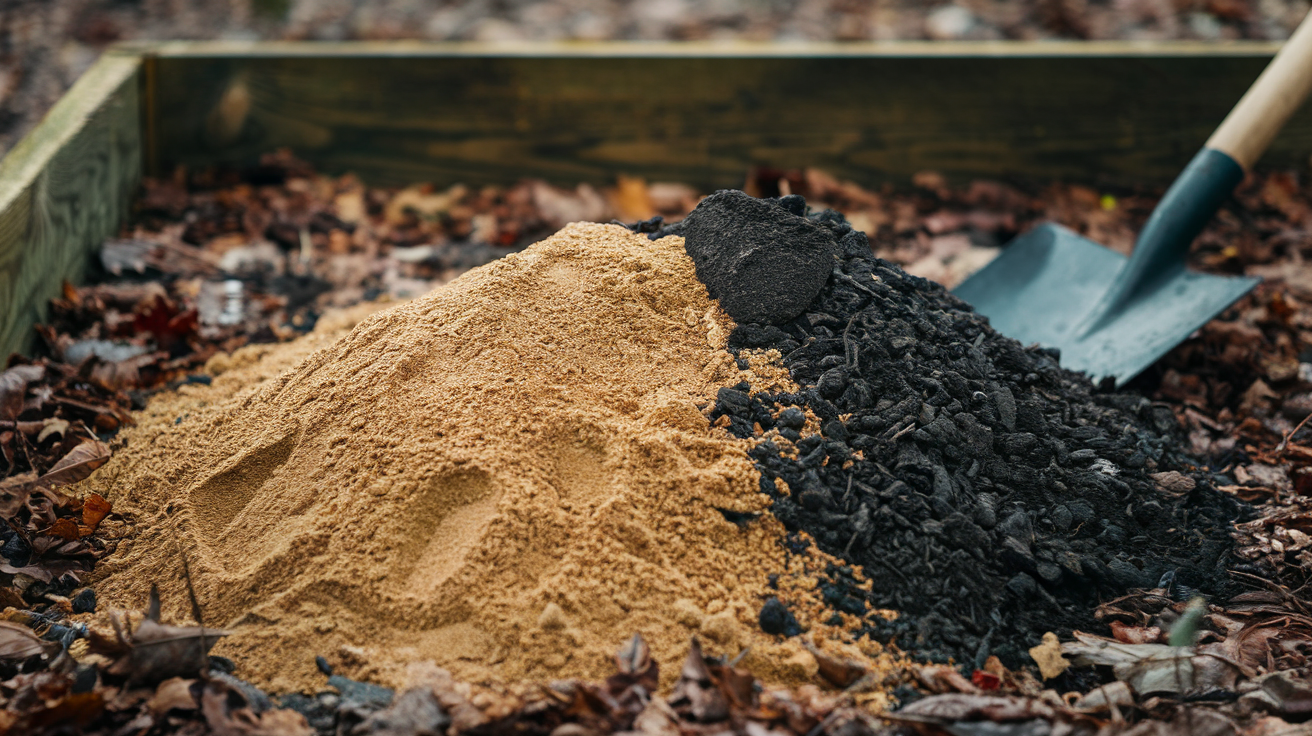Leveling your lawn or garden requires the right materials, and a sand-soil mix is often the go-to solution for achieving a smooth, even surface. Rhys Garden has found that the proper use of a sand-soil mix can make all the difference in creating a level and healthy growing environment. In this guide, I’ll explain how to use a sand-soil mix effectively for leveling and why it’s essential for your garden’s success.
What is Sand Soil Mix and Why is it Important for Leveling?
Sand soil mix, as the name suggests, is a blend of sand and soil that offers unique properties ideal for leveling garden beds, lawns, and other outdoor spaces. This mixture combines the drainage capabilities of sand with the nutrient-retention qualities of soil, creating a versatile medium that’s perfect for various landscaping projects.
To truly appreciate the value of sand soil mix, it’s essential to understand its composition:
- Sand: Provides excellent drainage and improves soil structure
- Soil: Retains nutrients and supports plant growth
- Organic matter: Enhances soil fertility and microbial activity
This balanced combination results in a mix that’s both stable and fertile, making it an excellent choice for leveling uneven surfaces in your garden.
Benefits of Using Sand Soil Mix for Leveling
When it comes to creating a level surface in your garden, sand soil mix offers several advantages:
- Improved drainage: The sand component helps prevent water logging, reducing the risk of root rot and other moisture-related issues.
- Enhanced soil structure: The mix creates a more porous environment, allowing roots to penetrate easily and access nutrients.
- Better compaction: Sand soil mix settles evenly, providing a stable foundation for lawns, patios, and garden beds.
- Versatility: It’s suitable for various garden projects, from filling low spots to creating raised beds.
How to Create the Perfect Sand Soil Mix for Leveling

Creating an effective sand soil mix requires careful consideration of your specific garden needs. Here’s a step-by-step guide to help you achieve the ideal blend:
Step 1: Assess Your Soil Type
Before mixing, it’s crucial to understand your existing soil composition. Conduct a simple soil test to determine its texture and pH level. This information will guide you in adjusting the sand-to-soil ratio accordingly.
Step 2: Choose the Right Sand
Not all sand is created equal when it comes to gardening. Opt for coarse sand or masonry sand, as they provide better drainage and aeration compared to fine beach sand.
Step 3: Determine the Ideal Ratio
A general rule of thumb for sand soil mix is:
- 1 part sand
- 1 part topsoil
- 1 part organic matter (compost or well-rotted manure)
However, this ratio can be adjusted based on your specific needs and soil type.
Step 4: Mix Thoroughly
Combine the ingredients in a large container or on a tarp, ensuring even distribution. Use a garden fork or shovel to mix thoroughly, breaking up any clumps.
Step 5: Test the Mix
Before applying the mix, perform a simple drainage test:
- Fill a pot with your sand soil mix
- Water it thoroughly
- Observe how quickly the water drains
If it drains too quickly, add more soil. If it’s too slow, incorporate more sand.
Applying Sand Soil Mix for Leveling: Best Practices
Now that you’ve created the perfect sand soil mix, it’s time to put it to use. Follow these best practices for optimal results:
Preparing the Area
- Remove existing vegetation and debris from the area to be leveled.
- Loosen the top layer of soil to ensure good integration with the new mix.
- Identify low spots and areas that require filling.
Applying the Mix
- Start by adding the sand soil mix to the lowest areas, gradually working your way up.
- Use a rake to spread the mix evenly across the surface.
- Tamp down the mix lightly to eliminate air pockets and ensure proper settling.
Watering and Settling
- Water the newly applied mix thoroughly to help it settle.
- Allow the area to dry for 24-48 hours.
- Check for any remaining low spots and add more mix if necessary.
Final Touches
- Once leveled, you can proceed with planting grass, laying sod, or creating garden beds.
- Consider adding a thin layer of topsoil or compost over the sand soil mix to provide additional nutrients for new plantings.
Common Challenges and Solutions When Using Sand Soil Mix
While sand soil mix is an excellent solution for leveling, you may encounter some challenges. Here are some common issues and how to address them:
Challenge 1: Excessive Drainage
Solution: If you notice that water drains too quickly, leaving plants thirsty, adjust your mix by incorporating more organic matter or clay-based soil to improve water retention.
Challenge 2: Compaction Over Time
Solution: To prevent the mix from becoming too compact, regularly aerate the area and incorporate organic matter to maintain soil structure.
Challenge 3: Nutrient Deficiency
Solution: Sand-heavy mixes may lack nutrients. Combat this by adding compost or slow-release fertilizers to ensure plants receive adequate nutrition.
Challenge 4: pH Imbalance
Solution: Sand can affect soil pH. Regularly test your soil and amend with lime (to raise pH) or sulfur (to lower pH) as needed.
Expert Tips for Maximizing the Benefits of Sand Soil Mix
To get the most out of your sand soil mix for leveling, consider these expert tips from the Rhys Garden team:
- Layer strategically: When filling deep depressions, apply the mix in layers, compacting each layer before adding the next to ensure stability.
- Consider your climate: In hot, dry regions, you may need to increase the proportion of organic matter to improve water retention.
- Use mulch: After leveling and planting, apply a layer of organic mulch to help retain moisture and suppress weeds.
- Monitor and maintain: Regularly check the leveled area for signs of settling or erosion, especially after heavy rains.
- Complement with appropriate plants: Choose plants that thrive in well-draining soil to make the most of your sand soil mix environment.
Sand Soil Mix for Different Garden Projects
The versatility of sand soil mix extends beyond basic leveling. Here are some creative ways to use this mixture in various garden projects:
Raised Beds
Sand soil mix is excellent for filling raised beds, providing good drainage and a stable growing medium for vegetables and flowers.
Patio Base
Use a modified sand soil mix with more sand content as a base layer for patios and walkways to ensure proper drainage and prevent settling.
Lawn Renovation
Topdress your existing lawn with a thin layer of sand soil mix to improve drainage and fill in low spots.
Container Gardening
Create a custom potting mix by incorporating sand soil mix with additional organic matter for container plants that require excellent drainage.
Environmental Considerations When Using Sand Soil Mix
As responsible gardeners, it’s essential to consider the environmental impact of our landscaping choices. Here are some eco-friendly considerations when using sand soil mix:
- Source locally: Opt for locally sourced sand and soil to reduce transportation emissions.
- Use sustainable materials: Choose organic compost and avoid peat-based products to protect natural habitats.
- Prevent erosion: Implement proper erosion control measures when working on slopes or near water bodies.
- Conserve water: While sand soil mix improves drainage, it’s still important to practice water conservation techniques in your garden.
FAQs About Sand Soil Mix for Leveling
To address some of the most common questions about using sand soil mix for leveling, we’ve compiled this FAQ section:
Q1: How much sand soil mix do I need for my project?
A: To calculate the amount needed, measure the area to be leveled and multiply it by the desired depth. For example, a 10×10 ft area filled to a depth of 2 inches would require about 1.5 cubic yards of mix.
Q2: Can I use play sand for my sand soil mix?
A: It’s best to avoid play sand as it’s too fine and can lead to compaction issues. Opt for coarse sand or masonry sand instead.
Q3: How long does it take for sand soil mix to settle?
A: Initial settling occurs within 24-48 hours after watering. However, complete settling may take several weeks, depending on weather conditions and foot traffic.
Q4: Is sand soil mix suitable for all types of plants?
A: While sand soil mix is versatile, some plants prefer more moisture-retentive soils. Research your specific plants’ needs and adjust the mix accordingly.
Q5: Can I use sand soil mix for filling holes in my lawn?
A: Yes, sand soil mix is excellent for filling holes and low spots in lawns. Ensure the mix is level with the surrounding grass to maintain a smooth surface.
Conclusion
Using a sand-soil mix for leveling is a practical approach that ensures your lawn or garden is even and well-prepared for planting. By choosing the right mix and applying it correctly, you can create a solid foundation that promotes healthy plant growth and enhances the overall appearance of your outdoor space. With careful attention to leveling, your garden will be set up for long-term beauty and functionality.

Related Posts
Best Soil for Indoor Plants: A Guide for Thriving Greenery
Topsoil vs Fill Dirt: Choosing the Right Soil for Your Garden
Understanding and Using Soil Moisture Meter Charts